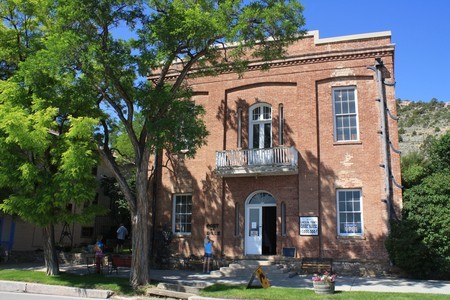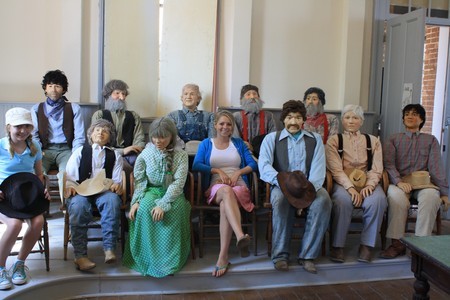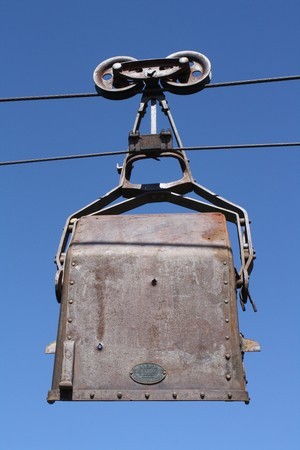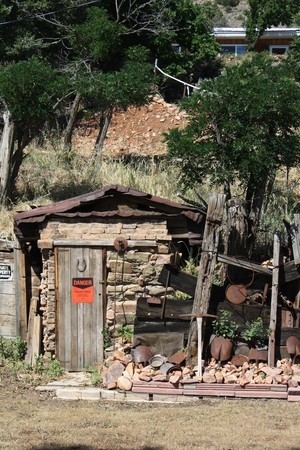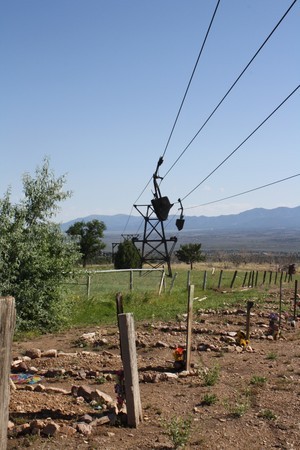A Nevada Treasure
Pioche had a terrible reputation. It was one tough town, wilder than Deadwood, Tombstone, Dodge City and Bodie," Jane Humphrey, tour guide at Picohe's "Million Dollar Courthouse" said.
It has been claimed that lawlessness was so rampant during the town's early years that 72 people died of gunshot wounds before one died of natural causes. Humphrey also said when Mark Twain stopped here, "He got off the stagecoach and there were two murders before he could even register at his hotel."
Most historians are skeptical of those specific numbers, especially given Twain's propensity to exaggerate. But they'll acknowledge Pioche was indeed plenty tough, one consequence of a rich strike in a remote location without effective law enforcement.
Silver ore was discovered here about 1863, and by 1869, things really got moving and a town was born. Word spread fast about the rich ore, and fortune-seekers flooded in. During the boom years from 1870 through 1877, more than $20 million of ore was mined -- a lot of money in an era when $4 a day was princely pay.
At one time, the population exploded to an estimated 10,000. By 1900, things were almost at a standstill, but there was a mining resurgence from 1939 to 1956, based on lead and zinc. Since then, mining has been sporadic, but the town remains the seat of Lincoln County, a retirement community and a welcome stop for travelers, hunters, and fishermen.
Pioche is now a quiet little town. Humphrey said there are about 1,500 full and part-time residents, although that seems about a thousand higher than I would think possible from its quaint, compact appearance.
My family and I visited the town earlier this month and spent a day immersing ourselves in history. This was an easy task because, like most 19th-century mining towns, it was laid out for people who walked to work, so every place we wanted to visit was no more than a 10-minute walk.
A lot of those walks are steep, however. Because Pioche was built on the side of the mountain containing the richest ore, it's called, appropriately, Treasure Hill. At an elevation of more than 6,000 feet, Pioche offers welcome respite from the Southern Nevada heat. The high that day was only 82 degrees.
We started our walking tour on Main Street, the hub of Pioche both then and now, and where at one time gunfights and knife attacks were frequent. The dead were brought down the then-unpaved thoroughfares to be buried in various cemeteries. The least respectable casualties tended to wind up in a small section called "Murderer's Row," or more familiarly, "Boot Hill."
In Boot Hill, we found a couple of dozen worn grave markers. One of the best-known markers we found remembers the Irish-born gunslinger Morgan Courtney. It reads, "Morgan Courtney, 1844-1873, Feared by some, respected by few, detested by others, shot in the back 5 times from ambush." Courtney apparently threatened to kill a man named William McKinney over a woman. Since Courtney was a known killer, McKinney took the threat as a real one and nipped the problem in the bud.
In front of many markers lies a worn cowboy boot, but a pair of white sandals marked the one woman's grave that was facing in the opposite direction. It read: "Fanny Peterson AKA, Panama Jack, Spanish Courtesan killed by her lover Lyman P. Fuller, Damn Shame." Other interesting markers include: "Shot by a coward as he worked his claim no one even knew his name," and "July 6, 1873, John Lynch, Shot over a dispute over a dog."
Overhead at Boot Hill stretches the Pioche aerial tramway, which operated from the 1920s to 1930s. Built by the Pioche Mines Company, it was used to bring ore down from Treasure Hill, above the town, to Godbe's Mill in the valley below. The structure vaguely resembles a ski lift with ore buckets in place of chairs hanging from a long loop of cable. It primarily operated on gravity, the full buckets traveling downhill providing nearly enough momentum to bring empty ones back up. It got a little help from a gasoline engine, but one that generated only five horsepower -- lawnmower-size. This was an extremely cost effective method of transporting ore, at about six cents per ton.
When Pioche became the county seat in 1871, plans were made to build a courthouse. It was contracted for a price of $16,400, with another $10,000 for the jail. Bonds were sold to raise money at a discounted rate and the brick-and-stone two-story building was completed one year later. That was the good news. But with cost over-runs, delayed payments and mounting interest, by the time it was paid off in 1936, and the building already condemned, the project's cost had shot up toward $1 million, a political sore point for decades.
The fully restored courthouse now serves as a museum and should be a highlight of any trip to Picohe. Most visitors' favorite part is the old jail, known as The Tank, built into the hillside directly by the back door to the upstairs courtroom. According to Humphrey, "people bought their way out every day."
Crimes ran the gamut from drunk and disorderly to the more serious, such as claim-jumping and impersonating the sheriff. Opium was a big problem, and jail served as a sort of rehab facility.
"They put them in the cell to detox," Humphrey said. She pointed through the jail's small doubled-barred windows toward the nearby outhouse, and said, "Once there were three prisoners who dug their way out of here, but the sheriff was in the outhouse, rearresting the three scoundrels with his trousers down around his knees."
The courtroom itself has humanlike mannequins dressed in period costume who sit in the correct places, depicting the judge and a sitting jury. There are even a couple of empty seats in the jury gallery, which visitors often occupy while having their photos taken, so they can later joke that they sat among a jury of dummies.
Other interesting exhibits in the courthouse include an 1894 voting booth that had two sides; you chose one depending how you were voting. With this setup, everyone knew how you voted.
Even during the town's untamed days, some people turned their talents to more cultural activities. R.G Schofield did have a mining claim but was also a teacher, watchmaker, engraver and artist. His delicately painted watercolors, 28 in all and primarily landscapes, are displayed on the second-floor hallway and courtroom walls.
We strolled back up Main Street to the Lincoln County Museum. The museum is jam packed with interesting antiques and historic items. We found a wide spectrum of mining, pioneer and American Indian artifacts, as well as a mineral collection. Some of the more interesting items we saw were a bobsled from 1900, old photographs and maps of Pioche, tepee poles and a variety of musical instruments.
"The most unique item we have is the Chinese laundry," said curator Leslie Childers. It includes a small cast iron stove, perhaps three feet high, with a variety of irons of different sizes surrounding the base.
Main Street is also home to a number of interesting and historic buildings, a couple of restaurants, bars, antique stores and a small grocery store. One popular gathering place is the Overland Hotel and Saloon. Even if you don't care for a drink, stop in and take a look around. Highlights include the 1868 mahogany Brunswick bar and the 1863 solid cherry back bar, The back bar was built and hand-carved in England then shipped around Cape Horn to San Francisco. The furniture served in the mining town of Kimberly, which was west of Ely, but has since disappeared from the map. It was shipped to Pioche in 1948.
Perhaps because of the town's history as a center of the formerly labor-intensive mining industry, Labor Day has been a big deal here for more than a century and is now the town's most important annual event. This year's celebration will be Sept. 4-7 and will include more than 100 activities, such as a turkey shoot, horseshoe pitching, a golf auction, fishing tournament, mining games, pet show, pie-eating contest and hay scramble. This year's raffle prizes will be a computer, a Wii game system including some games, and $200 in cash.
There are two parades, both themed "What I Do for Fun." Anyone interested is welcome to enter either parade or both. There is the smaller Saturday night Electric Parade and the larger Monday Labor Day Parade. The entries have cash prizes for family, youth, general and judges choice categories. Last year, there were more than 50 entries in the Labor Day Parade.
We had only a day to spend here, but it was enough to enjoy a big helping of small-town charm. Pioche's fame and prosperity peaked about 130 years ago, but some residents, and their descendants, never gave up their hometown. Continuous occupancy protected it from the vandalism and thoughtless damage that erased many a true ghost town from the face of Nevada. By accident, design, or some of both, residents preserved a place where today's city folks can feel what life must have been in small-town, 19th-century Nevada.
The miners are gone from Treasure Hill, but they left a treasure called Pioche.



